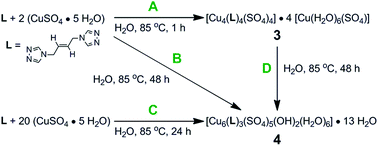Utilizing a copper MOF as a reagent in a solvent mediated reaction to form a topologically distinct MOF†
Abstract
Employing a semi-rigid di-1,2,4-triazole

- This article is part of the themed collection: New Talent: Americas
* Corresponding authors
a
Department of Chemistry, The University of Tennessee, Knoxville, Tennessee 37996-1600, USA
E-mail:
jenkins@ion.chem.utk.edu
Tel: +1(865)974-8591
Employing a semi-rigid di-1,2,4-triazole

 Please wait while we load your content...
Something went wrong. Try again?
Please wait while we load your content...
Something went wrong. Try again?
C. R. Murdock, Z. Lu and D. M. Jenkins, Dalton Trans., 2012, 41, 7839 DOI: 10.1039/C2DT30078H
To request permission to reproduce material from this article, please go to the Copyright Clearance Center request page.
If you are an author contributing to an RSC publication, you do not need to request permission provided correct acknowledgement is given.
If you are the author of this article, you do not need to request permission to reproduce figures and diagrams provided correct acknowledgement is given. If you want to reproduce the whole article in a third-party publication (excluding your thesis/dissertation for which permission is not required) please go to the Copyright Clearance Center request page.
Read more about how to correctly acknowledge RSC content.
 Fetching data from CrossRef.
Fetching data from CrossRef.
This may take some time to load.
Loading related content
